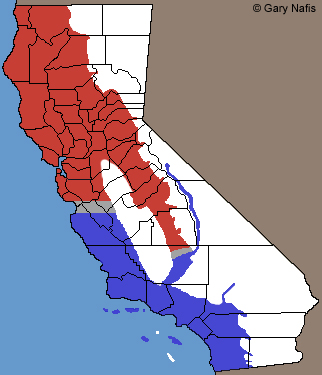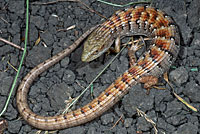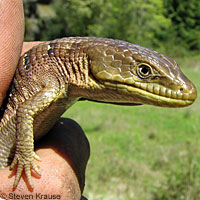Southern Alligator Lizard - Elgaria multicarinata
Forest Alligator Lizard (California Alligator Lizard)
-
Elgaria multicarinata multicarinata
(Blainville, 1835)
Description • Taxonomy • Species Description • Scientific Name • Alt. Names • Similar Herps • References • Conservation Status

Red: Range of this subspecies in California
Elgaria multicarinata multicarinata -
Forest Alligator Lizard (California Alligator Lizard)
Range of other subspecies:
Dark Blue: Elgaria multicarinata webbii -
Woodland Alligator Lizard (San Diego Alligator Lizard)
Click on the map for a topographical view
Map with California County Names
 |
|||||||||||||||||||||||||||||||||||||||||||||||||||||||
| Adult with complete original tail, Yuba County | |||||||||||||||||||||||||||||||||||||||||||||||||||||||
 |
|||||||||||||||||||||||||||||||||||||||||||||||||||||||
| Adult with tail that was broken off and has grown back, Contra Costa County | |||||||||||||||||||||||||||||||||||||||||||||||||||||||
 |
 |
 |
 |
||||||||||||||||||||||||||||||||||||||||||||||||||||
| Adult, Contra Costa County |
Adult, Alameda County | ||||||||||||||||||||||||||||||||||||||||||||||||||||||
 |
 |
 |
 |
||||||||||||||||||||||||||||||||||||||||||||||||||||
| Adult, Contra Costa County | Adult with regenerated tail, Contra Costa County |
||||||||||||||||||||||||||||||||||||||||||||||||||||||
 |
 |
 |
 |
||||||||||||||||||||||||||||||||||||||||||||||||||||
| Adult, Yuba County | Adult, Alameda County | ||||||||||||||||||||||||||||||||||||||||||||||||||||||
 |
 |
 |
 |
||||||||||||||||||||||||||||||||||||||||||||||||||||
| Adult with regenerated tail, San Mateo County |
Adult as found beneath a log in Napa County in January. |
||||||||||||||||||||||||||||||||||||||||||||||||||||||
 |
 |
 |
 |
||||||||||||||||||||||||||||||||||||||||||||||||||||
| Adult, Contra Costa County | Adult female, Napa County © Adam G. Clause |
||||||||||||||||||||||||||||||||||||||||||||||||||||||
 |
 |
 |
 |
||||||||||||||||||||||||||||||||||||||||||||||||||||
| Adult with regenerated tail, Sierra Nevada foothills, El Dorado County | Adult, Santa Cruz County | Adult, Yuba County | |||||||||||||||||||||||||||||||||||||||||||||||||||||
 |
 |
 |
 |
||||||||||||||||||||||||||||||||||||||||||||||||||||
| Adult, Contra Costa County | Adult, Contra Costa County | Adult with regenerated tail, Yosemite Valley, Mariposa County © Olly Burrows |
Adult, Sutter Buttes, Sutter County. © Jackson Shedd. Specimen courtesy of Eric Olson. |
||||||||||||||||||||||||||||||||||||||||||||||||||||
 |
 |
 |
|||||||||||||||||||||||||||||||||||||||||||||||||||||
| Adult with a regenerating tail that looks like a black spine, Santa Clara County © Alex Boyer |
Adult from along the Stanislaus River in Stanislaus County © Anonymous | ||||||||||||||||||||||||||||||||||||||||||||||||||||||
 |
 |
 |
|||||||||||||||||||||||||||||||||||||||||||||||||||||
| Adult, Santa Clara County © Yuval Helfman | Adult, Santa Clara County © Yuval Helfman |
Adult, Santa Clara County © Yuval Helfman |
|||||||||||||||||||||||||||||||||||||||||||||||||||||
 |
|||||||||||||||||||||||||||||||||||||||||||||||||||||||
| Adult, Santa Clara County © Yuval Helfman | |||||||||||||||||||||||||||||||||||||||||||||||||||||||
 |
|||||||||||||||||||||||||||||||||||||||||||||||||||||||
| Adult, Santa Clara County © Yuval Helfman | |||||||||||||||||||||||||||||||||||||||||||||||||||||||
 |
 |
||||||||||||||||||||||||||||||||||||||||||||||||||||||
| Adult, Humboldt County © Steven Krause |
Adult, Siskiyou County | ||||||||||||||||||||||||||||||||||||||||||||||||||||||
 |
 |
 |
 |
||||||||||||||||||||||||||||||||||||||||||||||||||||
| Adult, Siskiyou County | Adult, Siskiyou County | ||||||||||||||||||||||||||||||||||||||||||||||||||||||
 |
 |
 |
 |
||||||||||||||||||||||||||||||||||||||||||||||||||||
| Adult, Siskiyou County | |||||||||||||||||||||||||||||||||||||||||||||||||||||||
 |
 |
 |
 |
||||||||||||||||||||||||||||||||||||||||||||||||||||
| Adult, Del Norte County © Alan Barron |
Adult found a few miles northeast of Crescent City in Del Norte County © Steven Krause |
||||||||||||||||||||||||||||||||||||||||||||||||||||||
 |
 |
 |
 |
||||||||||||||||||||||||||||||||||||||||||||||||||||
| Alligator lizards are good climbers, using their somewhat prehensile tail to hold on, but they aren't easy to spot in trees since they blend in well with the branches. This adult with a very long intact tail frequents this Mulberry tree in Tulare County. © Sylvia Durando |
Alligator lizards got their name from their body shape and large scales that are similar to the scales on an alligator, but this sub-adult in Nevada County dove into a stream and swam away like its much larger more aquatic namesake. © Lou Silva | ||||||||||||||||||||||||||||||||||||||||||||||||||||||
 |
 |
 |
 |
||||||||||||||||||||||||||||||||||||||||||||||||||||
| Adult, Alameda County © Xiaopei Gelb This California Alligator Lizard has an extraordinarily long tail that has apparently never been broken. The bricks are exactly six inches high which makes the length of the lizard 12 or more inches which is as long as they get. |
Adult found in a Sacramento yard, Sacramento County © Benjamin Martinez |
Adult, Placer County © Teejay O'Rear |
|||||||||||||||||||||||||||||||||||||||||||||||||||||
 |
 |
 |
 |
||||||||||||||||||||||||||||||||||||||||||||||||||||
| This California Alligator Lizard was found with the rear half of its body stuck inside a discarded beer can in Santa Clara County. This might be proof that some lizards use beer cans as protective shells in the same way that hermit crabs use borrowed shells. Or more likely it just shows that the lizard entered the can looking for food or shelter (or maybe beer) and got stuck trying to get out. © Katie Quehl. | This California Alligator Lizard was found on a screen door in Alameda County. © Ameet Zaveri |
Adult from the border of Santa Clara and San Mateo Counties. © Yuval Helfman | |||||||||||||||||||||||||||||||||||||||||||||||||||||
 |
 |
||||||||||||||||||||||||||||||||||||||||||||||||||||||
| Adult, Santa Clara County © Yuval Helfman | A very red adult, Tehama County © Cory Walker | ||||||||||||||||||||||||||||||||||||||||||||||||||||||
 |
 |
 |
 |
||||||||||||||||||||||||||||||||||||||||||||||||||||
| Adult basking on a trail in the evening in Santa Clara County. © Yuval Helfman | The eye of this species is light, compared to the eye of the northern alligator lizard. | Adult males have a large triangular head. | All Western Alligator Lizards, genus Elgaria, have large rectangular keeled scales on the back that are reinforced with bone. (Elgaria multicarinata multicarinata is shown here). |
||||||||||||||||||||||||||||||||||||||||||||||||||||
Juveniles |
|||||||||||||||||||||||||||||||||||||||||||||||||||||||
 |
 |
 |
|||||||||||||||||||||||||||||||||||||||||||||||||||||
| Juvenile, Contra Costa County | Juvenile, Contra Costa County | ||||||||||||||||||||||||||||||||||||||||||||||||||||||
 |
 |
 |
 |
||||||||||||||||||||||||||||||||||||||||||||||||||||
| Juvenile, Contra Costa County | |||||||||||||||||||||||||||||||||||||||||||||||||||||||
 |
 |
 |
 |
||||||||||||||||||||||||||||||||||||||||||||||||||||
| Young juvenile, Contra Costa County | Juvenile, Contra Costa County | Juvenile, Santa Clara County © Yuval Helfman |
|||||||||||||||||||||||||||||||||||||||||||||||||||||
| Unusual and Interesting Pigments and Patterns | |||||||||||||||||||||||||||||||||||||||||||||||||||||||
| To see more unusually pigmented or patterned Southern Alligator Lizards, look at the Woodland Alligator Lizard page. | |||||||||||||||||||||||||||||||||||||||||||||||||||||||
 |
 |
 |
 |
||||||||||||||||||||||||||||||||||||||||||||||||||||
| This nearly patternless and colorless adult was photographed in Sonoma County. The eyes are the normal color, which rules out albinism, so this might be a leucistic lizard. © Lilith Schauer |
Very dark adult from Sacramento County. |
||||||||||||||||||||||||||||||||||||||||||||||||||||||
 |
 |
 |
 |
||||||||||||||||||||||||||||||||||||||||||||||||||||
| Adult with a yellow back, Colusa County © Andy Stocker | Adult with no black on the back and lots of orange coloring, Santa Clara County | ||||||||||||||||||||||||||||||||||||||||||||||||||||||
 |
 |
 |
|||||||||||||||||||||||||||||||||||||||||||||||||||||
| Adult with green coloring, Monterey County © Phil Gervato |
Very dark adult with regrown tail, Marin County © Anonymous | ||||||||||||||||||||||||||||||||||||||||||||||||||||||
Breeding Behavior |
|||||||||||||||||||||||||||||||||||||||||||||||||||||||
 |
 |
 |
 |
||||||||||||||||||||||||||||||||||||||||||||||||||||
| These lizards were found breeding in early May in Placer County. The photo on the right was taken the day after the photo on the left. They had been seen together for 2 days, travelling back and forth over a distance of about 30 feet. © Rod | A pair of adults mating in late May in Contra Costa County. © Naomi Schiff | Male and female courting in early May in San Joaquin County. | |||||||||||||||||||||||||||||||||||||||||||||||||||||
 |
 |
 |
 |
||||||||||||||||||||||||||||||||||||||||||||||||||||
| These copulating lizards were found in the middle of the city of Sacramento, in Sacramento County. © Leslie Hurlburt | This copulating pair of Forest Alligator Lizards was found in Sacramento in mid May. |
||||||||||||||||||||||||||||||||||||||||||||||||||||||
 |
 |
 |
|||||||||||||||||||||||||||||||||||||||||||||||||||||
 |
 |
 |
|||||||||||||||||||||||||||||||||||||||||||||||||||||
| This female alligator lizard was observed sitting on a trail in Santa Clara County. She started slowly moving in a circle lifting her tail and turning her head under her tail in a circle around her eggs. Normally a female would dig a place or find a sheltered place to lay and brood her eggs, so this behavior is hard to understand. Perhaps she was injured and laid the eggs prematurely. There's no way to know for sure but it's doubtful she was able to successfully incubate the eggs out in the open. © Wim de Groot |
|||||||||||||||||||||||||||||||||||||||||||||||||||||||
| Parasites | |||||||||||||||||||||||||||||||||||||||||||||||||||||||
 |
 |
 |
 |
||||||||||||||||||||||||||||||||||||||||||||||||||||
| It is common to find blood-engorged ticks attached to alligator lizards, especially in and around the ear openings, as you can see on the Forest Alligator Lizard on the left, on the Shasta Alligator Lizard in the middle, and on the San Francisco Alligator Lizard on the right. |
Adult Forest Alligator Lizard in Nevada County infested with ticks behind the ear. © Julia Ggem | ||||||||||||||||||||||||||||||||||||||||||||||||||||||
| Predators | |||||||||||||||||||||||||||||||||||||||||||||||||||||||
 |
 |
 |
|||||||||||||||||||||||||||||||||||||||||||||||||||||
 |
 |
 |
 |
||||||||||||||||||||||||||||||||||||||||||||||||||||
| This California Kingsnake was observed battling a Forest Alligator Lizard on a hiking trail in Santa Clara County. The alligator lizard clamped its jaws down on the snake's tail and held on tight even after it died. The snake had to pull and thrash about for more than 20 minutes before the lizard let go of the badly-damaged tail, finally allowing the snake to swallow it. © Wim de Groot | A California Striped Racer has caught a Forest Alligator Lizard in El Dorado County © Jim Bennett |
||||||||||||||||||||||||||||||||||||||||||||||||||||||
| Tail Loss Defense (Caudal Autotomy) | |||||||||||||||||||||||||||||||||||||||||||||||||||||||
 |
 |
 |
|||||||||||||||||||||||||||||||||||||||||||||||||||||
| As we were photographing the Alameda County alligator lizard seen above, my herping companion picked it up to get a better pose. The lizard had already been handled for 5 to 10 minutes and seemed to tolerate it, but this time it decided to drop its tail. We felt terrible to be responsible for the loss of such a nice unbroken tail. Sometimes when you pick up a lizard too close to the tail, or push the tail against a hard sufrace, you can accidentally cause it to detach, but that wasn't the case here. I put the writhing tail on the ground where it moved around for 4 - 5 minutes until it stopped, shooting some video of it, then set it back next to the lizard to get these photos. You can see the video here. The lizard was then put back under his log unharmed, but unable now to use a detached tail as a decoy until it grows another one. | |||||||||||||||||||||||||||||||||||||||||||||||||||||||
| Forked Tails | |||||||||||||||||||||||||||||||||||||||||||||||||||||||
| Sometimes when the tail of a Southern Alligator Lizard is broken off, two tails grow back from the break point. | |||||||||||||||||||||||||||||||||||||||||||||||||||||||
 |
 |
 |
|||||||||||||||||||||||||||||||||||||||||||||||||||||
| Adult, Placer County, with a forked regenerated tail. © Sara Walhovd | Adult, Los Angeles County with a large forked tail. © Joshua Nyhus | ||||||||||||||||||||||||||||||||||||||||||||||||||||||
| Habitat | |||||||||||||||||||||||||||||||||||||||||||||||||||||||
 |
 |
 |
 |
||||||||||||||||||||||||||||||||||||||||||||||||||||
| Oak woodland habitat, Contra Costa County |
Habitat, Contra Costa County | Habitat, Contra Costa County | Habitat, Yosemite Valley, Mariposa County |
||||||||||||||||||||||||||||||||||||||||||||||||||||
 |
 |
 |
 |
||||||||||||||||||||||||||||||||||||||||||||||||||||
| Habitat, 1900 ft., Siskiyou County |
Oak, Pine, grassland habitat, Napa County |
Habitat, Yuba County | Habitat, San Mateo County | ||||||||||||||||||||||||||||||||||||||||||||||||||||
 |
 |
 |
 |
||||||||||||||||||||||||||||||||||||||||||||||||||||
| Habitat, 2500 ft., Siskiyou County | Habitat, East Bay Hills, Contra Costa County |
Habitat, Alameda County | Adult in situ as it was found under a board in a forest clearing in Santa Clara County | ||||||||||||||||||||||||||||||||||||||||||||||||||||
| Short Videos | |||||||||||||||||||||||||||||||||||||||||||||||||||||||
 |
 |
 |
 |
||||||||||||||||||||||||||||||||||||||||||||||||||||
| A Forest Alligator Lizard is discovered under a board on a sunny spring afternoon. It tries to bite, crawls across the ground in snake-like fashion, tries to climb over the camera, sticking out its tongue, then ducks back under its board. | An adult is discovered under a piece of wood on a grassy hillside on a cold February afternoon in Contra Costa County. | A brief look at a juvenile Forest Alligator Lizard that refused to do anything interesting for the camera. | This video shows how an alligator lizard's tail thrashes around after it has been dropped to distract a predator. This is the same dropped tail seen above. The tail moved for about 4-5 minutes, which has been cut down here to about a minute, showing several different speeds until it is just barely moving. | ||||||||||||||||||||||||||||||||||||||||||||||||||||
 |
 |
||||||||||||||||||||||||||||||||||||||||||||||||||||||
| Two short movies of juvenile Forest alligator lizards uncovered in winter that don't want to move much for the camera until it's time to escape. | |||||||||||||||||||||||||||||||||||||||||||||||||||||||
|
|||||||||||||||||||||||||||||||||||||||||||||||||||||||
|
|||||||||||||||||||||||||||||||||||||||||||||||||||||||
|
The following conservation status listings for this animal are taken from the January 2024 State of California Special Animals List and the January 2024 Federally Listed Endangered and Threatened Animals of California list (unless indicated otherwise below.) Both lists are produced by multiple agencies every year, and sometimes more than once per year, so the conservation status listing information found below might not be from the most recent lists. To make sure you are seeing the most recent listings, go to this California Department of Fish and Wildlife web page where you can search for and download both lists: https://www.wildlife.ca.gov/Data/CNDDB/Plants-and-Animals. A detailed explanation of the meaning of the status listing symbols can be found at the beginning of the two lists. For quick reference, I have included them on my Special Status Information page. If no status is listed here, the animal is not included on either list. This most likely indicates that there are no serious conservation concerns for the animal. To find out more about an animal's status you can also go to the NatureServe and IUCN websites to check their rankings. This animal is not included on the Special Animals List, which indicates that there are no significant conservation concerns for it in California. |
||
| Organization | Status Listing | Notes |
| NatureServe Global Ranking | ||
| NatureServe State Ranking | ||
| U.S. Endangered Species Act (ESA) | None | |
| California Endangered Species Act (CESA) | None | |
| California Department of Fish and Wildlife | None | |
| Bureau of Land Management | None | |
| USDA Forest Service | None | |
| IUCN | ||
|
|
||
Return to the Top
© 2000 -


